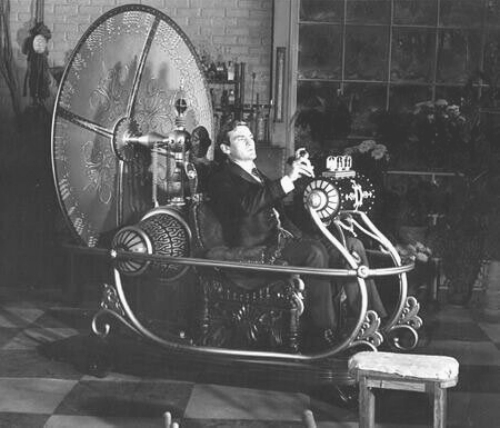
free web hit counter
The Disintegration of Time
The Real Story of How the Clever Little Clock Works
Copyright © 2009..... Geoff Kait, MACHINA DYNAMICA

Introduction
The Clever Little Clock is a battery-powered travel clock the size of an iPhone that has been extensively modified using many highly specialized techniques. At least 19 steps are required to produce the Clever Little Clock, somewhat more for the new Signature version. The clock can be placed anywhere in the room with excellent results for both the sound quality of audio systems AND the picture quality of video systems. The Clever Little Clock is based on concepts and techniques that were developed by PWB Electronics, Leeds, England and is designed and manufactured exclusively by Machina Dynamica. May Belt of PWB Electronics provided assistance with this theory of operation.
Machina Dynamica introduced the original Clever Little Clock in 2005. However, we did not provide any details of its operation in all this time - until now. Since its introduction, there has been some speculation that the Clever Little Clock is an acoustic resonator, an emitter of some sort or an EMI/RFI channeler. But, it's none of those! The Clever Little Clock's operation actually has to do with time itself - how the past catches up with us -- like a predator. The real story of how the Clever Little Clock works involves man's inherited fight-or-flight response to danger and the evolution of his memory system -- how memories are created, stored and retrieved. The clock's operation also involves the significance of two different time references -- one that was operating when the recording was made and one that's operating in the future when the recording is played.
Predators, Evolution and our Internal Clock
Man's internal clock evolved during the Dawn of Man as a survival mechanism. This internal clock is a function of the brain that time-sequences sensory information - most notably, perhaps, moving images and sound - so the information can be stored in and retrieved from memory chronologically. Early man's chronological memory allowed him to calculate a predator's location, speed and direction of movement and figure out, on the spot, if it was barreling down on him or not. Timing in memory operation was critical since sensory information had to be retrieved from memory in precisely the same sequence and speed it was stored - otherwise, it would be all jumbled together and wouldn't make sense.
Early man continually scoped out his environment for danger. When he saw or heard - or otherwise sensed - a predator nearby, fear, confusion and anxiety automatically kicked in -- the fight-or-flight response, also called the acute stress response. Predators of early man were very impressive, capable of producing acute stress -- hyenas as big as bears, ferocious saber-toothed cats like Smilodon (see photo) and raptors like the African Crowned Eagle.
 Photo courtesy University of California at Berkeley
Photo courtesy University of California at Berkeley
Saber-toothed Tiger (Smilodon)
To assess a predator's threat, early man analyzed images and sounds of the predator to determine its location (x, y, z), velocity (dx/dt, dy/dt, dz/dt) and direction of movement. Early man's internal clock time-stamped each millisecond of the predator's motion and sound with a unique time coordinate (Present Time, tn). Thus, early man calculated the predator's position, velocity and direction by comparing/analyzing frames of data in very recent memory - e.g., the frames time-stamped tn through tn-10. The fight-or-flight response temporarily degraded or distorted early man's senses of vision (tunnel vision) and hearing (auditory exclusion) as other biological processes, such as adrenaline release, took precedence, somewhat hampering his threat assessment efforts.
Man's chronological memory did not disappear when early predators like Smilodon became extinct, but continued to evolve since some other early predators survived and new ones arrived on the scene as time went by. Man is still prey to grizzlies, saltwater crocs and tigers in some parts of the world. A man standing on the corner waiting to cross the street relies on his sensory perception, internal clock and chronological memory to rapidly assess the speed of a car barreling down on him.
Chronological Memory
Our internal clock controls how memories are stored and retrieved. If we wish to reminisce about a favorite book or movie we can recall the highlights fairly easily, and if we put our minds to it we can remember scenes from movies in remarkable detail - scenes many hundreds of frames or more in length. A movie's images and sounds are "videotaped" by our eye and brain, then stored in memory chronologically. Furthermore, the movie's images are integrated, synchronized with the movie's soundtrack in memory. If our memory was not chronological we wouldn't be able to recall high-density, multiple-frame scenes from movies and replay them in our mind's eye. The brain even has a Scene Selection feature similar to a DVD player's so we can consciously select specific scenes from a movie and replay them in our mind's eye like, say, Remember Sammy Jankis or Memories can be Distorted from Memento.
Our internal clock is always running, whether we're conscious of it or not. Sometimes we awake just before the alarm clock goes off because we know it's time to get up. All the things we see and hear and do are time-stamped with Present Time coordinates. Thus, the next day, the following week or ten years later we're able to associate specific times in the past with our experiences. "What were you doing last Tuesday evening?" "Let's see, at 8 O'clock I was watching Total Recall. At 9 O'clock I watched Altered States."
So, whether we're aware of it or not, we maintain a continuous record of events, sounds, words and images, including time of occurrence. We can sing a song from memory or play a musical instrument. With a little effort we can remember passages from books and movies like Roy Batty's death speech in Blade Runner, "I've seen things you people wouldn't believe. Attack ships on fire off the shoulder of Orion. I watched C-beams glitter in the dark near the Tannhauser gate. All these moments ...will be lost... in time... like tears... in rain. ...Time to die."
Time is Relative
The Clever Little Clock addresses an esoteric but fundamental problem that occurs when playing an LP, CD, DVD or any other audio or video media. This problem also occurs when watching taped programs on television or listening to recorded programming on the radio in your car or at home. In all of those cases the observer is confronted - subconsciously - by time coordinates that are different from the Present Time coordinates he's been using his entire life to time-stamp sensory information. What are these interfering time coordinates, where do they come from and why are they a problem?
The alien time coordinates are contained in the recording (or videotape). The time coordinates (of what was then Present Time) of the recorded performance, millisecond by millisecond, are captured inadvertently along with the acoustic information. When a recording is played, the time coordinates from the recording session (which are now Past Time coordinates) are reproduced by the speakers along with the acoustic signals of the recorded event. Those Past Time signals become entangled, integrated in the listener's mind with Present Time signals. Because the listener is accustomed to using Present Time signals to synchronize his chronological memory, he subconsciously perceives the confusing, interloping Past Time signals as a threat. This perceived threat produces the fight-or-flight response, which in turn degrades his sensory capabilities. The reason that live television broadcasts, like the Superbowl and the 2010 Olympics, are generally observed to have superior audio and video compared to taped broadcasts is that they don't contain Past Time signals, only Present Time ones.
The time coordinates on the recording are associated with the 4-dimensional spacetime coordinate system (x, y, z, t), where t ranges between the start time and end time of the recording session. While you could say that t0 of the spacetime coordinate system marks the first instant of the Big Bang, it's the relative difference between Past Time and Present Time that's important, not the difference between t0 and Past Time or Present Time.
In H. G. Wells' The Time Machine, George demonstrates a working scale model to a group of skeptical friends. He sets the time machine's clock to 10 minutes in the future and pushes the start lever. The time machine then disappears in front of their eyes. The time machine disappears because, although it's still in the same place on the table, it's occupying a different spacetime (x, y, z, t) in the future. The x, y, z space coordinates are the same, but the time coordinate t is Present Time + 10 minutes. The time machine reappeared 10 minutes later.

Götterdämmerung
Let's say a recording was made of a live performance of Götterdämmerung with the Berliner Philharmoniker on July 21, 1930 between 12 Noon and 5 PM. During the performance the actual time coordinates of what was then Present Time - a unique time coordinate for each instant of the performance - are somehow captured on the recording along with the acoustic information of the musical instruments and singers. When the recording of Götterdämmerung is played at some point in the future - say, one day in 2010 - the stream of time coordinates from July 21, 1930 is projected into the listening room by the speakers along along with the acoustic information. The two out-of-synch streams of time coordinates - the Past Time coordinates from July 21, 1930 and the Present Time coordinates - confuse the listener and reduce his sensory acuity. So, even though the glorious sound of the Berliner Philharmoniker is reproduced in the room the listener cannot hear it in all its glory.

Summary
The time signals that are captured on the recording back when it was made are out of synch with the time signals when the recording is played. Those Past Time signals are reproduced through the speakers along with the acoustic information and become entangled, integrated with Present Time signals the listener uses to time-sequence sounds and images in memory. The alien time signals from the past are perceived subconsciously by the listener as a threat, producing fear, anxiety and confusion: the fight-or-flight response inherited from his Prehistoric ancestors. That fear, anxiety and confusion reduce or distort the listener's hearing and visual acuity. The Clever Little Clock counteracts the perceived threat produced by the Past Time signals, improving the listener's hearing and vision acuity by disentangling, dis-integrating the Past Time signals from the Present Time signals in his subconscious mind.
About the Author: Geoff Kait, education: Aerospace Engineering (theoretical fluid dynamics, propulsion, statistical thermodynamics, nuclear physics, indeterminate structures). Work experience: NASA satellite operations and radar data analysis; aerodynamics of high-performance aircraft and reentry vehicles; radio and satellite communications; spread spectrum communications. He incorporated Machina Dynamica in 1998 and designed the Nimbus Sub-Hertz Platform, Promethean Base, Special Helical Springs, Brilliant Pebbles, The Super Intelligent Chip, the Clever Little Clock, Codename Turquoise II, Codename Top Banana II, Tru Tone Duplex Covers, Frog Jump in Water Sound Tweak, Codename White Poppy, Codename Blue Meanies, the Quantum Temple Bell, the Diamond Light Crystal, Flying Saucers for Windows, Flying Saucers for Wall Outlets, Sonic Tonic Anti-static Spray, Spectrum Purifier CD Coloring System, Blu Spectrum Blu Ray Coloring System, Dark Matter Optical CD Spray and the Teleportation Tweak.
________________________




